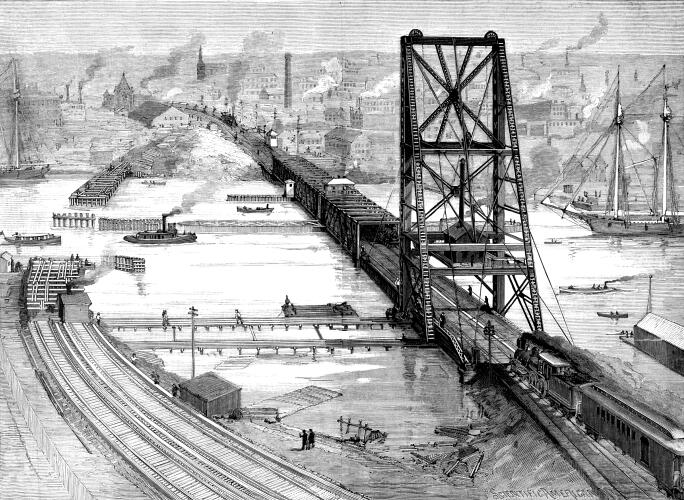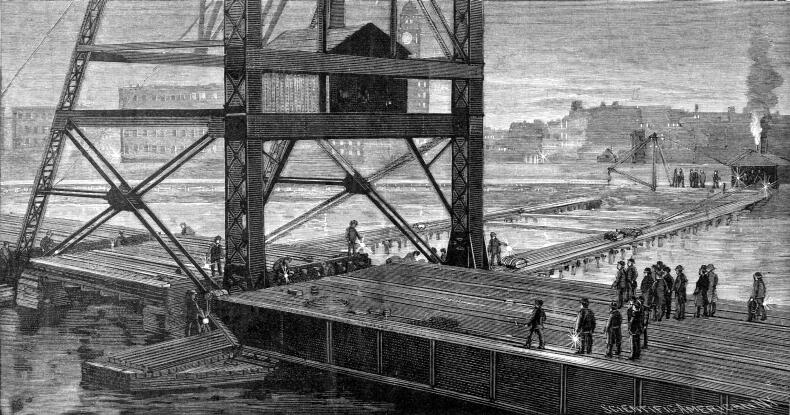IMPROVEMENTS AT THE HARLEM
RIVER BRIDGE.
Scientific American—December 31,
1892
 There are
three railroad bridges across the Harlem River, the estuary connecting
the water of Long Island Sound with the Hudson River. The principal
one of these bridges, situated in the line of Fourth Avenue, is
used by the New York Central, the Harlem, and the New Haven Railroads
for their passenger traffic principally. An immense number of
trains pass over it daily, so much so that it has become insufficient
for its uses. It included always a center swinging draw. This
draw was struck so often by passing boats that apprehensions were
entertained as to its working perfectly. Accordingly, to preserve
the integrity of the river navigation, and also of the railroad
transit, an auxiliary draw was erected adjoining the swinging
draw. This second one, from the designs of Mr. G H. Thompson,
of the New York Central road, was of the lifting type. In the
upper cut, this draw is seen in position nearest the front of
the picture, while immediately back of it is the old swinging
draw. The floor of the new drawbridge was carried on the top of
plate girders, which were free to swing up or down on horizontal
pivot or hinge joints immediately adjoining the front of the tower.
To open the draw, it was simply pulled upward, rising into a vertical
position. To effect this operation, cable hoisting machinery was
provided, and to give scope to its operation, the tower, shown
in the cut, was erected. There are
three railroad bridges across the Harlem River, the estuary connecting
the water of Long Island Sound with the Hudson River. The principal
one of these bridges, situated in the line of Fourth Avenue, is
used by the New York Central, the Harlem, and the New Haven Railroads
for their passenger traffic principally. An immense number of
trains pass over it daily, so much so that it has become insufficient
for its uses. It included always a center swinging draw. This
draw was struck so often by passing boats that apprehensions were
entertained as to its working perfectly. Accordingly, to preserve
the integrity of the river navigation, and also of the railroad
transit, an auxiliary draw was erected adjoining the swinging
draw. This second one, from the designs of Mr. G H. Thompson,
of the New York Central road, was of the lifting type. In the
upper cut, this draw is seen in position nearest the front of
the picture, while immediately back of it is the old swinging
draw. The floor of the new drawbridge was carried on the top of
plate girders, which were free to swing up or down on horizontal
pivot or hinge joints immediately adjoining the front of the tower.
To open the draw, it was simply pulled upward, rising into a vertical
position. To effect this operation, cable hoisting machinery was
provided, and to give scope to its operation, the tower, shown
in the cut, was erected.
The tower is an iron lattice work structure, 126 feet high,
with a base 34 feet 6 inches wide and 48 feet 6 inches long. Its
front pillars are vertical, and within them counter weights were
provided to relieve the hoisting machinery of most of the strain
of lifting the draw. It will be seen that in raising the bridge
from a horizontal position, less and less power is required. Accordingly,
the system was so arranged that as the bridge rose, counterweights
were successively detached, thus compensating for the decreased
moment of the structure. The bridge has now to be removed and
replaced by another structure. Independent of the requirements
of present traffic on the Harlem River, it is obvious that when
the improvements now under way shall have been completed by the
Federal government, it will become a waterway of considerable
importance to the city. The bridge also is of increasing importance
with regard to the railroad traffic, and the opening of its draw,
even now, has had to be restricted, owing to the number of trains
which have to pass it. A new bridge is to be built, elevated nearly
30 feet above the water, so that the majority of boats can go
under it without the draw being opened. In accordance with the
requirements of the Federal government, the new draw in the new
bridge will have to give a minimum opening of 100 feet at right
angles to the axis of the stream. As the bridge runs at an angle
with this axis, the full opening of the draw will exceed 165 feet
on each side of the center pier. The drawbridge truss which will
swing in its center therefore will be about 400 feet long, and
will carry four lines of tracks. The bridge will be the continuation
of the elevation of the tracks in Fourth Avenue—a colossal
work soon to be begun.
To enable the new bridge to be constructed, a temporary bridge
is to be built at one side of it, which is shown in the upper
cut. When this bridge is finished, trains will use it, and the
old structure will be demolished and replaced by the elevated
bridge just mentioned. The temporary bridge, however, must have
a draw, and the Federal engineers exacted a minimum width, requiring
trusses 106 feet long. The old trusses of the lifting draw spanned
but a little more than 90 feet. To provide the new draw for the
temporary bridge, it was determined first to move the tower bodily
into position in line with the temporary bridge, and to use it
to raise and lower the lattice girder draw, 106 feet in span.
The line of travel of the tower having been decided on, rows of
piles were driven; caps were placed on them, and on these 12 by
12 longitudinal timbers were placed. Rails were then spiked down
on the timbers so as to form a horizontal sliding way. The tower
was jacked up bodily 3 feet after being stripped of counter weights
and other material so as to make it as light as possible. It is
calculated that 100 tons weight were thus removed, of which 85
tons were represented by the counter weights alone. Even when
this was done, the residual weight was in the neighborhood of
180 tons. When the tower was thus elevated, slideways in continuation
of those laid on the outside were placed under it. The rails were
lubricated with Dixon's plumbago lubricator and the tower was
lowered upon them. A six-spool hoisting engine with falls of very
large size, with great sheave blocks, being 18 inches in diameter,
was arranged to draw the tower away from the bridge along the
line of the slide. Some apprehension was felt as to the success
of the operation, but it was found that the tower might be moved
a distance of 8 feet without interfering with traffic, so it was
decided that here, at least, was room for experiment. Accordingly,
before the final operation, the tower was moved back and forth
to distances of a few feet to test the practicability of the operation.
When everything was ready, the final operation of moving, illustrated
in the lower cut, was executed. It was done at night, in order
to avoid interruption to traffic. At 12:30 A. M., the tracks were
cut by the railroad company, and the way was cleared for the tower
to be drawn out from its position. The foreman in charge of the
work, as a signal code, arranged at one motion of his hand to
indicate one revolution of the engine. When all was clear, the
engine was started, first slowly, and then more rapidly, and in
21 minutes the great mass was moved 54 feet. The railroad company
replaced the tracks, and by 3:20 A. M. all was ready for traffic
once more. There was absolutely no interruption to traffic. The
tower is to be moved along on its present course until the line
of the new temporary bridge is reached, when it is to be moved
forward in position. When installed here, the lattice girders
will be put in position. As this will then be the only drawbridge,
hoisting machinery of double the power of the original will be
put in, so as to insure rapid operation.

The work of moving the tower was done by the firm of Coffrode
& Saylor, of this city, who were its original constructors.
All the operations were in charge of their foreman, Mr. Maylan,
and the entire work was successful in every sense of the word.
Stories Page | Contents Page
|







